Get To Know the Graptopetalum Genus
Graptopetalum is a genus of eighteen species, and it falls under the family Crassulaceae. All species under the genus have the common names Ghost Plants and Leather Petal. These common names are due to the most common physical characteristics that traverse species in the genus; the pale color and the rosette structure of leaves, respectively. The pale, ghost-like appearance is usually occasioned by the whitish powdery wax, an evolutionary defense against the ultraviolet rays from direct sunlight.
This genus naturally occurs in Mexico and Arizona in relatively dry areas, in hardiness zones 7b to 11. It now adorns homes all over the world as a decorative plant. Rosettes are a big part of the plant’s attraction, and fleshy leaves and stems also characterize it. Due to the fleshiness of its leaves and stems, Graptopetalum is the actual definition of a succulent.
Quick Growing Guide
Botanical Name: Graptopetalum amethystium, Graptopetalum bellum and many more
Genus: Graptopetalum
En français: Graptopetalum
Sun / Shade:
Water: Moderate, overwatering can lead to root rot and pest infestation.
Soil:
Height
Graptopetalums are short plants, but not all of them have stems. Those with limbs attain ten to fifteen centimeters in height, but they are not many in the species. Most of the plants that fall under this species are acaules which means they dint have stems. The acaules don’t grow beyond a height of five centimeters. These succulents’ growth can be described as a medium; they grow neither too slowly nor too fast. You may need to repot your plant after two years; it is after this period that it may have outgrown the pot.
Flower colours
Graptopetalums flower, but the color of these flowers varies between species. Flowers grow from a woody stalk that grows every flowering season. The flowers typically wither fast, and though they enhance the plant’s beauty, they are not its main attraction. It is lovely when taken care of, and plants in this genus are not fussy, so busy gardeners or those without much experience can grow them to their highest beauty standards. You can plant this plant indoors or outdoors as part of xeriscaping.
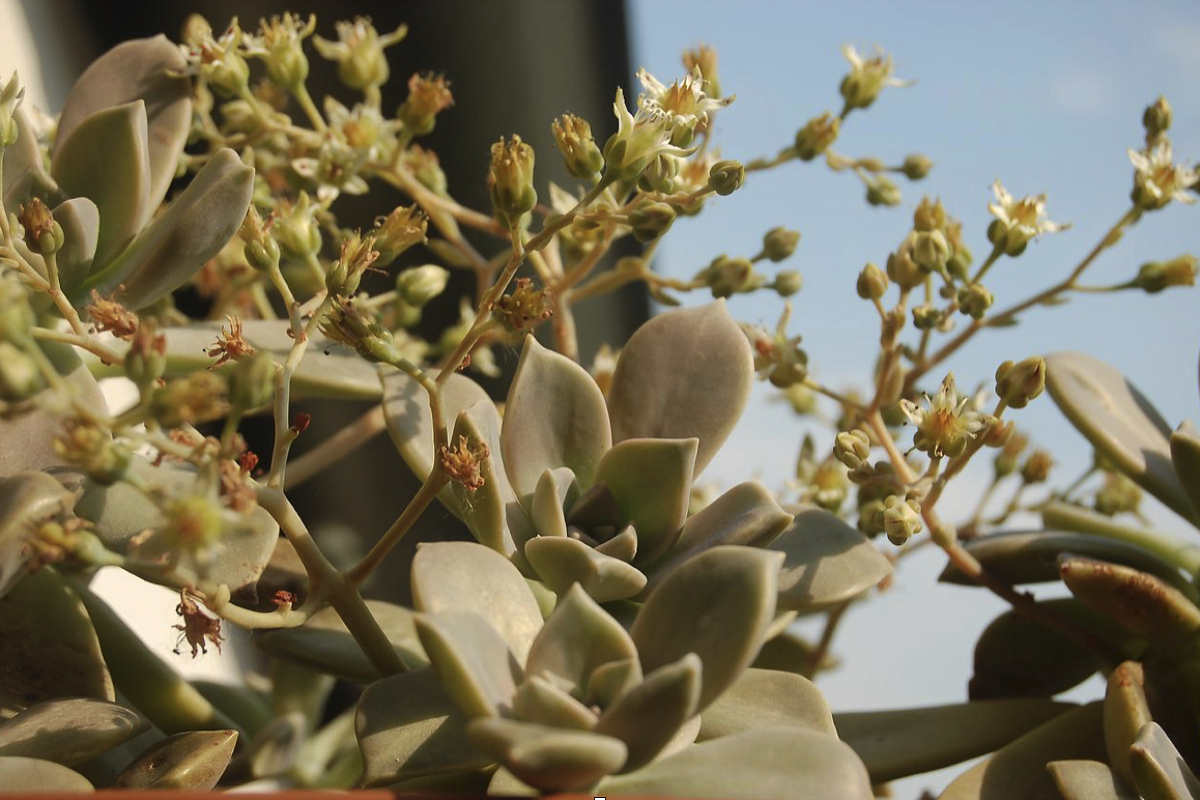
How to care for Graptopetalum
The following is how you care for your Graptopetalum under the topics below.
How to Water
Watering is one of the most critical aspects of care for succulents. Too much of it destroys the roots, and too little of it will cause the plant to stunt. The amount of water you give to this plant depends on its location and the season.
If you have planted the succulent outdoors in the sun, the water will evaporate faster, and you will need to replenish it often. Check the first inch of your pottage to see if it has moisture; give it another drink if the pottage is dry, and hold off watering if there is still moisture in the soil. Of course, the ground won’t drain as fast if the plant is indoors, but the method applies, water only when the first inch of pottage has no moisture.
Please note that this plant grows in cold seasons, and it will need water to facilitate growth. Unlike other succulents, watering it in summer doesn’t mean reducing the watering in winter. It will use up the water for its development, albeit not as fast as the summer heat would evaporate it.
This succulent doesn’t have a lot of leaves, its growth is more upward than outward, and it, therefore, doesn’t cover the pot. This means that you can water it from above without wetting its leaves.
How to Plant
The soil where you plant your Graptopetalum should be well-draining to protect the plant from root rot when the plant sits in the water. If you are going for commercial pottage, buy cactus mix and then mix it with some pumice to enhance the soil’s drainage. In the event, you want to combine the ground at home. Please give it a mix of loamy and sandy soil in equal parts. This way, the earth will drain quickly and satisfactorily.
Put the soil in a pot, preferably a breathable pot that allows water to evaporate through. This enhances drainage for your spoil and its breathability. After having everything in place, make a hole at the center of the pot and place your seedling. Water the soil, ensuring you don’t overwater it, leading to fatal waterlogging.
How to Propagate
This genus has three propagation methods: leaf, cuttings, offsets, and seeds. The following is how you propagate each.
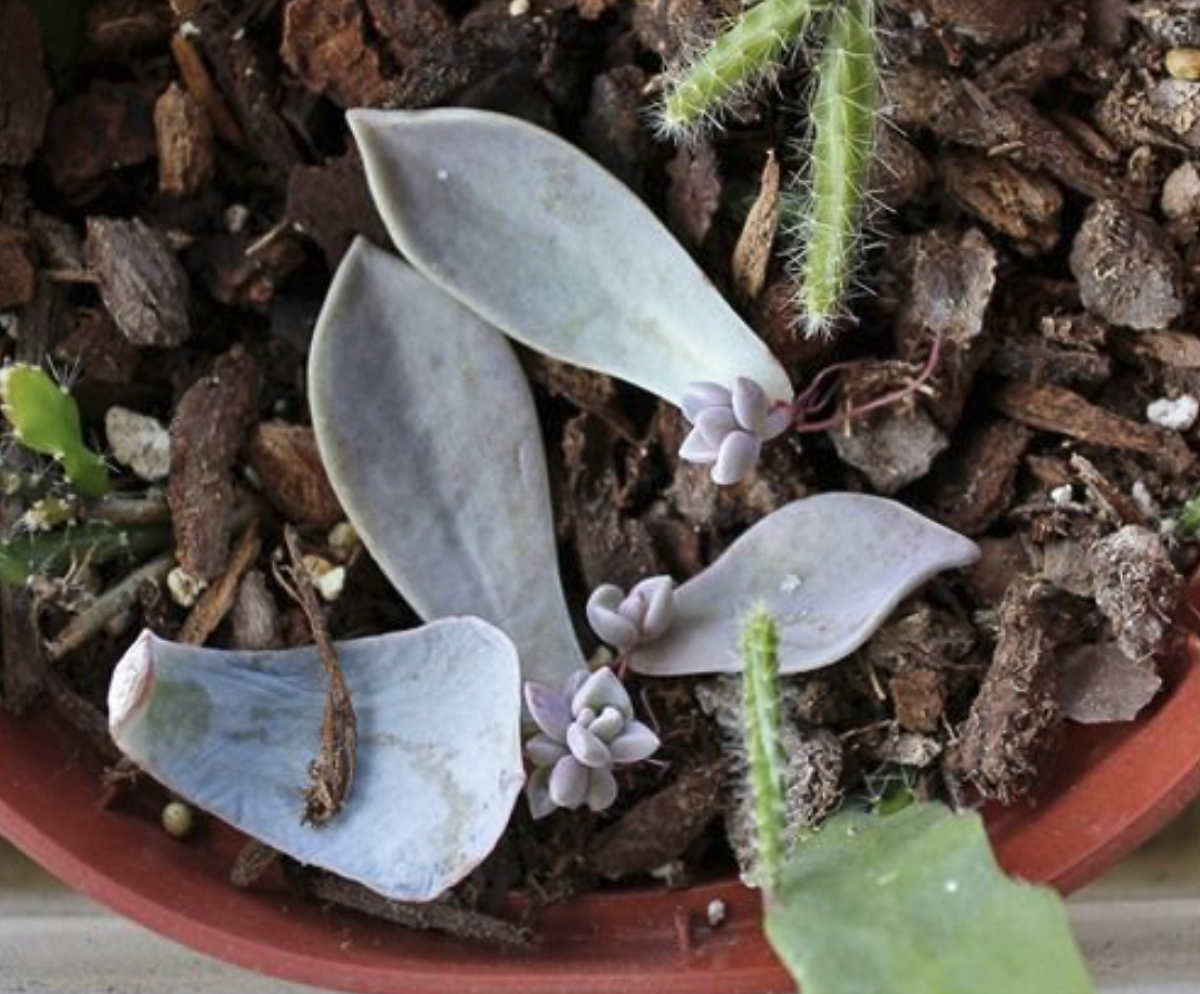
Propagation by leaf and cuttings
Follow the following steps.
- Cut a healthy, mature leaf from the plant. The best leaves for propagation are always the ones on the lower side of the plant. Make sure they aren’t dried up with age, as some of the leaves in the rosette are wont to do from time to time.
- Allow the leaf to be calloused under a shade for about three or four days.
- Put the leaf-cutting in the potting soil. The soil should be suitable for the growth of Graptopetalum.
- Keep the soil moist but not too wet, as this is the ideal watering condition for the plant.
Treat your cutting the same way you treat the leaf as described above. If you are propagating using a cutting, cut it with a clean, sterilized knife from a healthy stem. There should be nodes in the cuttings because rooting happens at the node.
Propagation by Offsets
Graptopetalum produces offsets which form when the mother plant sends roots out into the soil, and other plants develop from the edges of these roots.
You can let the offset grow into an independent plant in the same pot with enough space or move it into a different pot for a new plant.
Move the offset, allowing it to grow until it takes the plant form, and cut it off from the mother at the root using a sterilized blade. Put the baby plant in a pot of moist, well-drained soil and allow it to grow. An offset sources faster than a leaf or cutting, and it becomes a plant more quickly since it is already relatively well-formed.
Propagation by Seeds
Buy certified seeds for these succulents. Certified seeds ensure more excellent production than any seeds you might produce at home unless you are an expert. Plant the seeds one inch deep in a pot or bed and water gently from time to time. The seeds can take up to a month to germinate, after which little rosettes will start emerging. Transplant them into their pots and continue with the care routine we shall describe later in this article.
You should propagate the plant at the beginning of spring to take advantage of its growing season, which is spring and summer. Planting at any other time will only prolong the waiting period. It may even cause your cuttings and seeds to rot.
Some popular Graptopetalum succulents
There are eighteen known species in this genus, but the following are some of the most popular used for decoration.
Graptopetalum amethystium
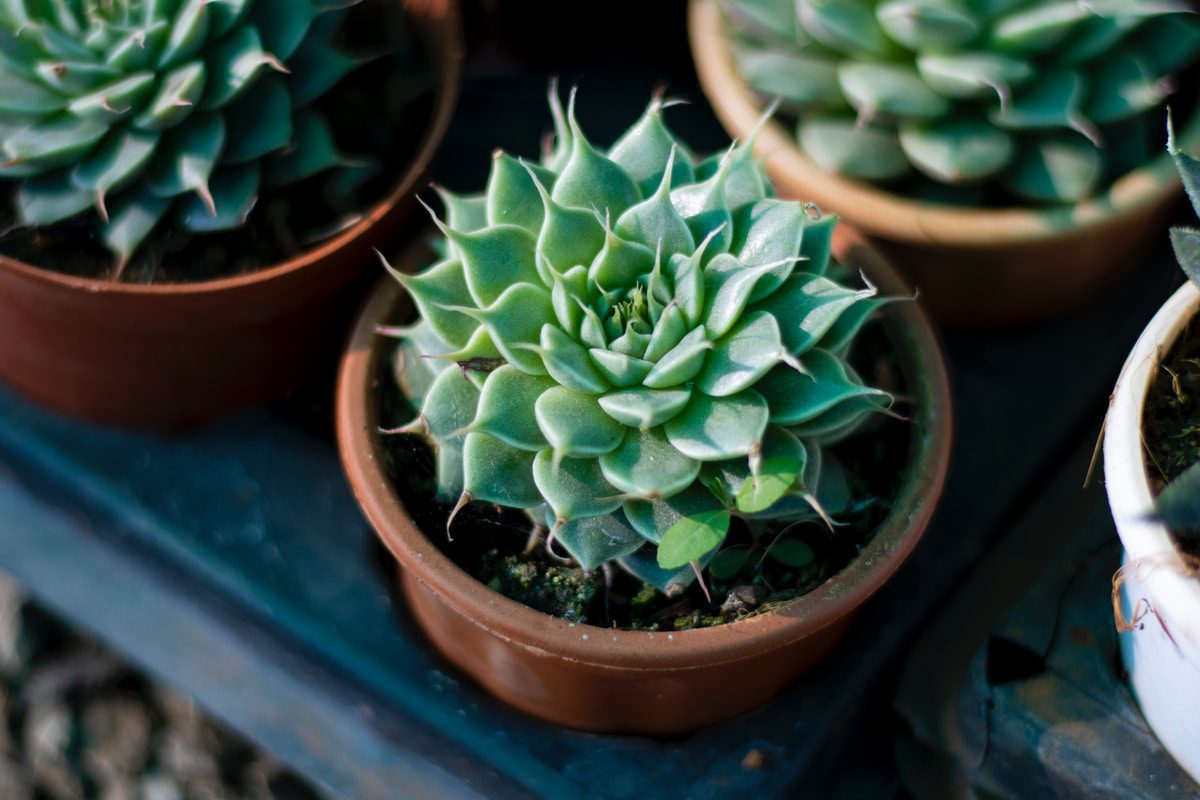
This Graptopetalum is a native of the Jalisco area of Mexico. It is a perennial succulent that grows between 5 to 15 centimeters, with evergreen leaves. The leaves are also blue-green, and they don’t form elaborate rosettes like other species in the genus. Sometimes the leaves can get a pinkish hue. This Graptopetalum produces red flowers which complement the shade of its leaves nicely. The flowers appear in July and August. This Graptopetalum has the common names, Jewel-Leaf Plant and Lavender Pebbles.
Graptopetalum bellum
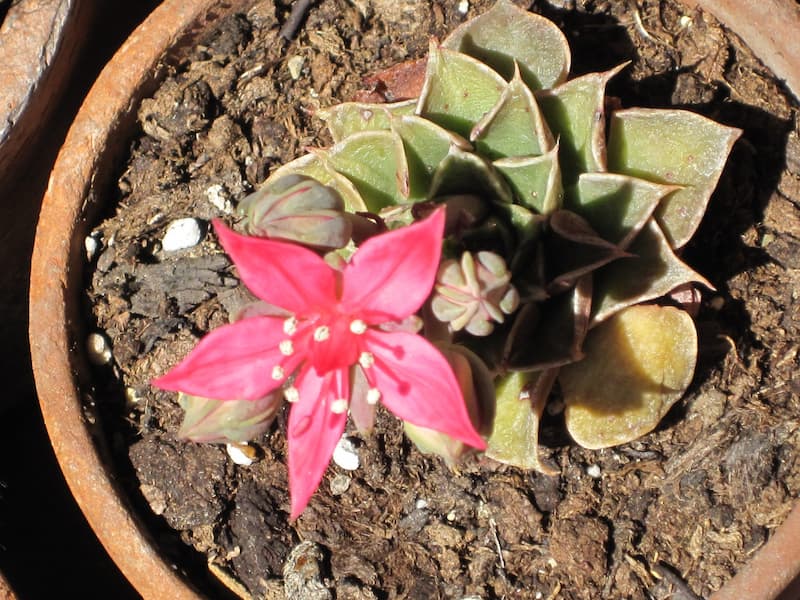
This native of Mexico is an acaule; it doesn’t have a stem. The leaves are angular, almost pointy, and have a gray-green color with a whitish margin. The plant doesn’t exceed ten centimeters in height due to the lack of stem. This [plant produces pink flowers that usually grow to a width of 2.5 cm towards the end of spring and early summer. The rosette can attain a maximum width of ten centimeters. It grows slowly; it takes five to ten years to achieve the maximum height, which, as we have mentioned, doesn’t go beyond ten centimeters.
Graptopetalum macdougalii
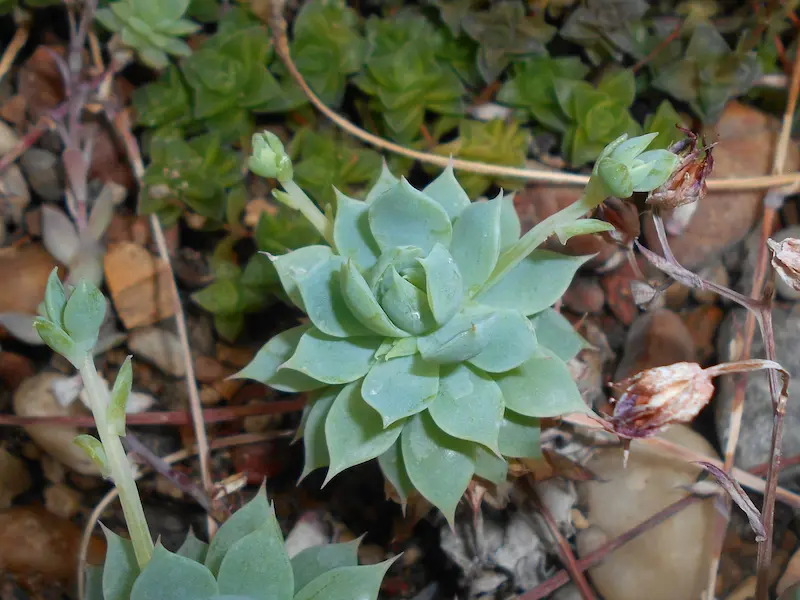
This plant is short and dense; it forms mats from its rosettes—the mat forms due to the presence of auxiliary runners that proceed from the main plant. You can describe the leaves as tongue-shaped, and their color can range from bright blue to green. The Macdougalii’s leaves have a waxy surface that is rather typical of Graptopetalum; the wax gives it a silvery glow. It is a slow-growing plant that doesn’t require too much water. Macdougalii usually produces offsets which can form a large, course clump on the ground.
Graptopetalum mendozae
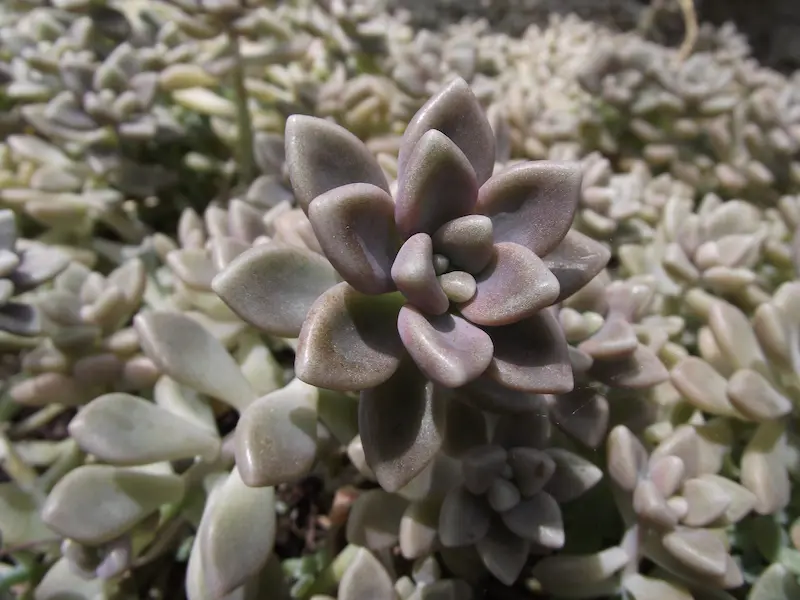
This stemmed Graptopetalum grows to a maximum of 15 centimeters. It has fleshy, oblong leaves. The unique feature of the plant is its lilac leaves which make the plant appear to be made of ivory. It is a native of Mexico, and it produces offsets. The uniqueness of the color of its leaves is further enhanced by the fact that when you expose it to strong sunlight, the leaves tend to turn golden! It produces white star-shaped flowers from woody stalks typical of Graptopetalum. Since it doesn’t grow high, it extends horizontally through the increase of succulents.
Graptopetalum paraguayense
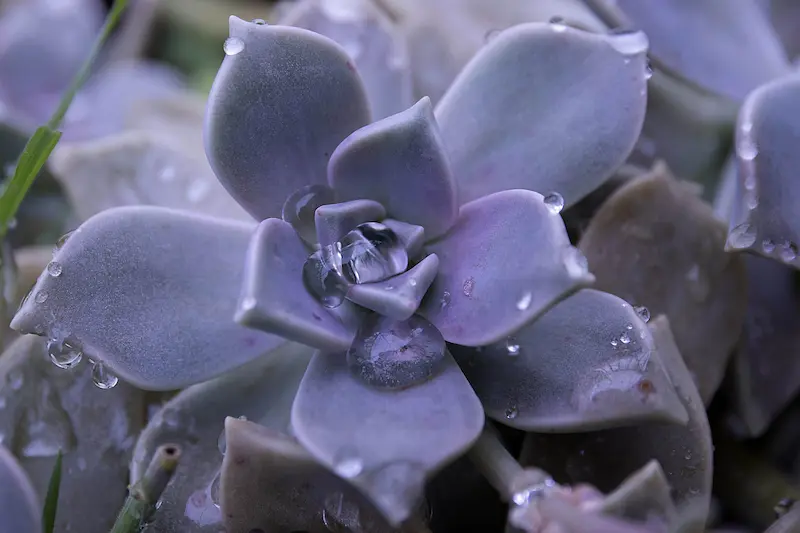
In Mexico, where it originates, the plant is referred to as the Mother of Pearl Plant. The reason for the name is the whitish-green colored leaves that look a little like pearls. Its leaves are obovate, and it produces star-shaped white flowers. Each rosette in the plant is about four inches wide, and it is pointy. Besides the pearly leaves, Graptopetalum paraguayense can get a pink-yellowish pigmentation when grown in hot, dry conditions. The blue-gray pigmentation occurs in partial shade.
Graptopetalum superbum

This graptopetalum is another native of Jalisco, Mexico. Its common name is marble rose. It is among the tallest Grapropetalums, and it can reach a height of 20-25 centimeters in its natural habitat. It produces star-shaped green-yellow flowers. The flowers also have reddish spots, and they bloom in late winter.
Final Thought
Graptopetalum is one of the easiest plants to manage. The most critical aspect of its care is watering; ensure you don’t overwater it. Grooming is simple as it only involves removing dried-up leaves. The care regime for the various plants in this genus is more or less the same.
About the Author
Hi, my name is Richard Miller. I am a succulent enthusiast and the owner of this beautiful blog Succulent City. I want to share my joy and love for succulents with every reader on the Internet. Happy reading!







Leave a Reply
You must be logged in to post a comment.